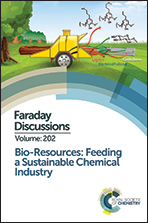Feedstock selection for polymer and chemical production: feedstock-specific recalcitrance
Abstract
Plant cell wall materials derived from a range of waste biomass sources have great potential as a source of sustainable alternatives to petrochemicals. Perhaps the most straightforward way of realising this potential would be to hydrolyse the most efficiently fermentable polymers into their constituent sugars and use yeast to ferment these into useful chemicals. However, it also makes sense to pre-extract components which have a greater value in polymeric form. This is particularly true for non-cellulosic polymers, which are rich in poorly-fermentable pentose sugars. Liquid hot water (LHW) pretreatment can be used to extract non-cellulosic carbohydrates in a cost-effective manner, leaving a cellulose-rich substrate which is easier to hydrolyse using commercial cellulases. However, inherent differences in the plant cell wall structure and composition mean that some biomass sources may be more suitable for exploitation than others. Here, we examine eight different feedstocks (two each from hardwood, softwood, cereal straws and dicotyledonous crops), expose them to 26 different LHW pretreatment conditions and hydrolyse the entire pretreated slurry with a commercial cellulase. This enables side-by-side comparisons, in terms of saccharification yield, of the feedstocks. The results clearly demonstrate considerable differences in suitability between the feedstocks, in relation to the quantity of products released and the processes needed to obtain them.
- This article is part of the themed collection: Bio-resources: feeding a sustainable chemical industry

 Please wait while we load your content...
Please wait while we load your content...